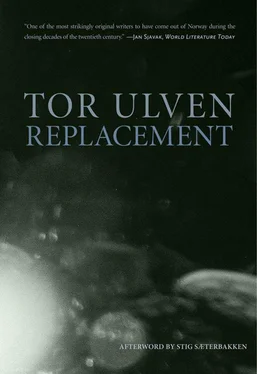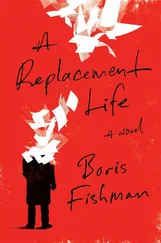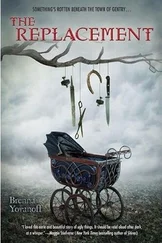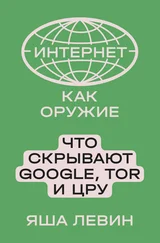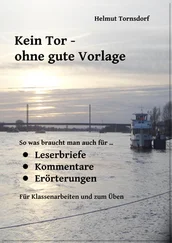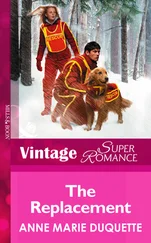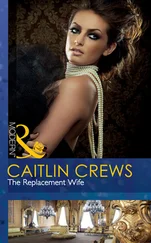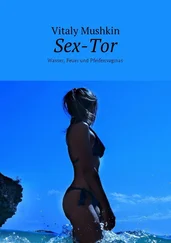The frame’s solid, rich, and detailed ornamentation, with flora and fauna adorning the corners, volutes and cartouches symmetrically adorning each side, and the huge, teardrop stone (one earring) lying in front of it, or rather to the right of the candle, the long white pearl necklace, which looks like it’s been carelessly discarded, or wrung, as if in doubt, until it appears almost knotted, or like a segmented creature with a hard shell, or some mysterious undersea life form. You can see the sharp, rectangular shadow cast by the mirror (together with its frame) across the back wall, as black as the darkness within the mirror itself (and if it weren’t for the candle’s reflection, you would think it was just an empty gold frame against darkness); you can also see the woman, who’s dressed in a full white linen blouse, which is rich with folds (her upper arms and elbows are just shadows through the cloth), the woman sitting there and staring in the direction of the mirror, presumably without seeing her own reflection, the woman whose breath (or sigh) presumably sets the flame to dancing now and then; her face is half turned away, and you see her pale profile, as well as her blouse’s loose, V-shaped neck, which opens to reveal her breasts, her smooth, back-length, brown, nearly black hair, which is cast back over one shoulder, and the crimson skirt that falls over her feet and obscures them, and the strong, one might even say powerful, plump, folded hands (loosely folded, fingers slightly splayed, so that the fingers of her left hand cast shadows across the back of her right) atop the skull in her lap.
This time the candle is positioned on the seat of a red leather chair, which illuminates the woman on the stool at chest height. She’s clearly wearing a nightgown, which has been drawn up to her thigh and is also falling open, so that her breasts tumble out. Her hair is wrapped up in some kind of scarf or turban, her face wears an expression of mute concentration, she’s bending her head so her neck disappears and it looks like she’s got a double chin, her lowered eyelids tell you she’s focused on her hands, which she holds between her stomach and breasts, while she clenches them tightly together so that only the thickest finger joints are visible, entwined (taken out of context, they actually resemble horse teeth); her thumbs are bent and pressed together at the nail, where, if you look closely, you can see (or think you can see) the louse she’s in the process of squishing, hence the candle placed at chest height. You call to mind the popular theology prevalent in her century, the belief that from the dawn of creation it was already predetermined which souls would enjoy eternal salvation and which would suffer eternal damnation, so that the damned were damned long before they ever actually existed, and the saved were saved long before they ever existed too, and life, strictly speaking, was just a superfluous, symptomatic demonstration of what had already been decided and would remain so from eternity to eternity; in which case, you think, earthly life might as well be declared null and void, and the damned simply declared damned directly in the hereafter and the saved saved directly in the hereafter and then the damned sent straight to hell and the saved sent straight to heaven, from eternity to eternity, without letting ordinary life break out like a pox, and in that case your scars wouldn’t have had to wait millions of years to meet your face, instead they would’ve been standing there all along, distinct and clear as Cartesian ideas from eternity to eternity.
The small popping sound where nail meets nail and the louse meets its end. Maybe it’s audible in the otherwise empty room. Maybe she can feel the fetus moving inside her, as her hands rest upon her swollen stomach, where the fetus is growing, its cells continually splitting, while the louse, for its part, is dying between her thumbnails. In any case, at least this woman is focused on something real, something that actually is (namely, the louse), in contrast to the first woman, who sits by her mirror in apparently richer surroundings and meditates over death and transience, focusing all her mental energy on what doesn’t exist, or doesn’t yet exist, or once existed, or something that contains all these qualities, because she’s not staring at a louse, or at the mirror, or at the flame, or at the flame’s reflection in the mirror, no, she seems to be staring at the darkness, or at the contrast between the light and the darkness, as if she’s already anticipating the darkness that’ll fall the moment the flame flickers, flares up, and dies, or more precisely, the moment the red-orange glow vanishes from the wick, sending up a wisp of smoke (which will be invisible in the darkness), although she’ll recognize the strong, unmistakable scent of a candle gone out, but all she’ll see is the wavering afterimage left by the flame, and finally just a few flickering, fluctuating points of light.
That moment hasn’t arrived. There’s still time to wait and think, to stare into the mirror, as you’re doing now, without seeing anything but the glowing flame and its reflection, the elegant flame that flickers and writhes and shifts color, although it stays more or less blue around the wick, more or less red along the outer rim, or white, a white light filtering as though from a slit falling on a strip of paper, accompanied by a weak, rattling, grumbling, electrical sound, like the kind made by an old adding machine, and you realize you must have been traveling for a while now, though you don’t remember anything that happened after you stepped into the car. Obviously, it’s happened again, you’ve had a complete and total blackout without dreams or visions, and it lasted longer this time, as if your life were a film and some spiteful person had gone and clipped several minutes out of it, or as if it were a book with page after page of perfectly printed text, and then a blank page, and then perfectly printed text again, as if you’d been brain-dead, a dead brain stuck in a living body for about five minutes (or however long it’s been), and even though you’re awake, you’re in danger of disappearing again, it could happen any minute; you don’t like it, and you should probably see a doctor, you think, after you’ve done what needs to be done. There’s light enough (though the morning rush-hour traffic hasn’t even started) to see the buds on a birch tree, like little green tongues sticking out of dark husks, when the car stops at the next intersection, while, in answer to your question, the driver informs you that it’s a data feed with information about routes, mainly about routes, but also reports of bus stops with long lines, blocked roads, possible traffic accidents, hazardous driving conditions (for example, a drunk guy impeding traffic on this or that street), stolen cars, or other criminal activity.
The long, rolling Pacific thunder, which you can hear from your bungalow’s terrace up above the sandy beach, where blue waves gather themselves before being smashed to foam upon the sand, there’s no winter here, you think, no season but the long, endless summer, but even then trade winds ensure it never gets too hot. You ask if the machine lets him send messages out too, but the driver tells you that he has to use the radio for that. Your driver likes to go fast (he’s pushing the speed limit), but to keep the ride smooth, staying in high gear as he cruises along the four-lane highway. As you pass by, you see a store selling light fixtures, hundreds of them in every conceivable shape and size, and every one of them is lit inside the old, white, wooden house (probably a private residence once), as if the fixtures were a flock of odd creatures clumped together for the night, fireflies, say, or maybe a hive of bees, or else rocks, clusters of rocks containing gleaming crystals, precious stones, diamonds even, and, horrified, you contemplate the enormous electric bill this kind of extravagant advertising must produce, money that could’ve been better spent elsewhere.
Читать дальше
